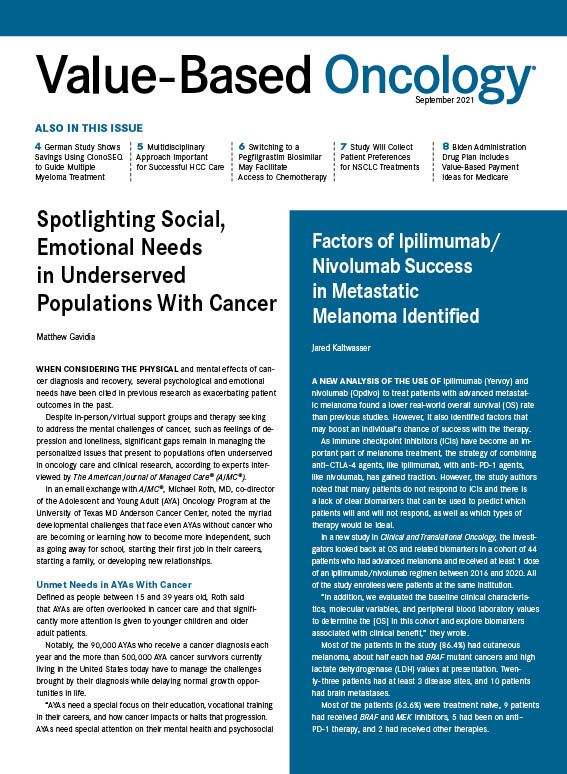- Center on Health Equity & Access
- Clinical
- Health Care Cost
- Health Care Delivery
- Insurance
- Policy
- Technology
- Value-Based Care
German Study Shows Savings Using ClonoSEQ to Guide Multiple Myeloma Treatment
Study authors found that knowing a patient’s minimal residual disease status can help pinpoint the right multiple myeloma therapy to improve overall and progression-free survival.
A study funded by the makers of the clonoSEQ test to detect minimal residual disease (MRD) found the test could achieve significant savings if used to treat patients with multiple myeloma, especially if used over longer periods, based on a model using Germany’s health care system.
The authors found use of the MRD diagnostic would allow “more efficient use of high-cost drugs” in the treatment of multiple myeloma, and that “therapy decisions can be better and more precisely controlled if the MRD status of patients is known before the next therapy phase.”
The authors acknowledged that their findings might not directly apply to a health care system that relies on private coverage, such as the system found in the United States. Other adjustments for demographic factors and care settings that differ by location might affect the precise experience by country, but the authors felt the key takeaways would hold up:
- Knowing a patient’s MRD status can help pinpoint the right multiple myeloma therapy to improve overall and progression-free survival.
- MRD testing through next-generation sequencing can help payers by putting downward pressure on the overuse of high-cost drugs, especially in multiple myeloma, which is often treated for a period of 10 years or more.
The cost-effectiveness of clonoSEQ was modeled based on Germany’s statutory insurance program. The authors started with clinical data derived from recent trials and expert opinion, with the primary data source being a 2009 phase 3 trial conducted at 69 centers involving the 3-part regimen known as RVD, for Revlimid (lenalidomide), Velcade (bortezomib), and dexamesthasone.
Following induction, stem cell mobilization with cyclophosphamide and granulocyte colony-stimulating factor was performed in all patients. For consolidation, one group (RVD-alone group) received 5 cycles of RVD with a reduced dose of dexamethasone; the other arm, the transplant group, received melphalan plus autologous stem cell transplant and 2 cycles of RVD, followed by maintenance, which continued for a year or until consent was withdrawn. The RVD-alone group could receive salvage transplant therapy.
The primary end point was progression-free survival; 350 patients were assigned to each group. In the RVD group, 331 patients entered consolidation in the RVD-alone group and 321 reached maintenance; in the transplant group, 323 received a transplant and 315 received RVD therapy after transplant and 311 entered maintenance.
A cost impact analysis of clonoSEQ was then derived, using these data and the available literature. Investigators created a Markov model that consisted of 6 healthy states, with every patient beginning at the start of maintenance, using an MRD arm and one without clonoSEQ testing. The therapies included in the model were lenalidomide for maintenance and carfilzomib, lenalidomide, and dexamethasone for relapse.
Over a period of 10 years, the analysis showed a total cost of €279,483 ($330,533) for patients using clonoSEQ compared with €356,623 ($421,867) for simulated patients without MRD testing. The main drivers of the cost differences are the cost savings from patients being able to take a “drug holiday,” based on MRD testing. The savings per patient in 1 year are €18,396 ($21,761). Savings after 3 years are €69,991 ($82,775) per patient. Savings after 10 years are €77,140 ($91,230) per patient.
“Based on the underlying model, clonoSEQ can support German health insurance funds to use high-cost drugs more efficiently in the treatment of myeloma,” the authors concluded.
Funding for the study was provided by Adaptive Biotechnologies.
Reference
Walzer S, Krenberger S, Vollmer L, Hewitt T, Eckert B. A cost impact analysis of clonoSEQ as a valid and CE-certified minimal residual disease (MRD) diagnostic compared to no MRD testing in multiple myeloma in Germany. Oncol Ther. Published September 4, 2021. doi:10.1007/s40487-021-00169-x

Trends in Hospital Pricing for Vulnerable Emergency Department Users, 2021-2023
December 4th 2025Self-pay emergency department prices rose significantly from 2021 to 2023, especially at for-profit and system-affiliated hospitals, highlighting growing affordability challenges for uninsured and underinsured patients.
Read More
